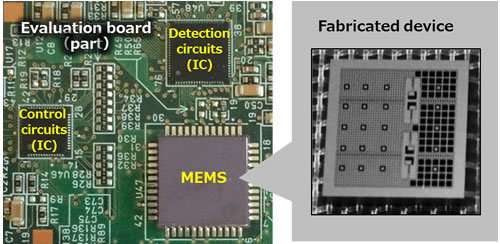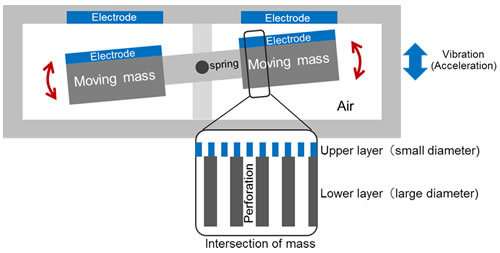High-sensitivity low-power MEMS accelerometer for detecting extremely weak ground and building vibrations

Hitachi Ltd. today announced the development of a high-sensitivity low-power MEMS accelerometer that can detect extremely weak ground and building vibrations by combining sophisticated MEMS technology with circuit technology. The sensor achieves a comparable sensitivity to that of sensors for oil & gas exploration (noise level 30ng/√Hz) with less than half the power consumption (20mW). Hitachi intends to apply this sensor to various applications including next generation oil & gas exploration, and infrastructure monitoring, to contribute to the realization of a comfortable, safe and secure society.
The progress over recent years in the fusion of OT (Operational Technology) and IT (Information Technology) has led to an increasing expectation on high performance sensors, which represent a key component. For example, in oil & gas exploration, sensors with three orders of magnitude higher sensitivity than automotive sensors are required as they need to be able to detect extremely weak underground reflection waves resulting from applied artificial earthquakes. Also, power consumption of these devices needs to be drastically reduced to enhance feasibility, as use-cases such as next-generation resource exploration may need to deploy sensors in the order of one-million at sites, or may require a battery-life of many years, as in infrastructure monitoring for bridges and buildings. In conventional MEMS accelerometers, however, it was difficult to achieve high sensitivity and low power consumption at the same time since power consumption increases proportionally to the square of the reduction in noise.
To overcome this challenge, Hitachi developed a high-sensitivity low-power MEMS accelerometer by converging sophisticated combination of MEMS and circuit technologies. Features of the developed technologies are as follows.

Low-noise MEMS using a moving mass with unique perforations
MEMS accelerometers consist of a moving mass suspended by weak springs and circuits to detect and control movement. The circuits detect the movement of the mass generated by the vibration or the acceleration as electrical charge signals, and control the mass based on the signal to keep it to a balanced position, however, the noise caused by the air molecules colliding with the surface of the moving mass result in reduced sensitivity. In this development, unique perforations with different entry/exit diameters based on fluid dynamics analysis were made on the moving mass, consisting of an SOI substrate, resulting in a halving of air molecule collisions.
Low-power circuit through parallel operation of control and detection
In conventional MEMS accelerometers, a common electrode is used when alternately switching between control and detection operations. This method consumes much power as a high control voltage is required to switch between operations due to the short duration of the control period. In the proposed sensor, independent electrodes are provided for control and detection, and therefore control and detection operations can be performed simultaneously, and the high voltage required to prepare for control can be eliminated, resulting in a 40 percent reduction in control voltage required for the control operations.
In evaluating the technology developed, it was found that the sensitivity (noise level 30ng/√Hz or less) required for sensors used in oil & gas exploration, could be realized with a power consumption of 20mW, which is approximately half that of conventional levels. As a result, it will be possible to apply MEMS accelerometers to situations which require a large number of high-sensitivity low-power sensors, such as the detection of extremely weak ground or building vibrations.
Hitachi intends to apply this sensor to various applications including next generation oil & gas exploration, and infrastructure monitoring, to contribute to the realization of a comfortable, safe and secure society.
Provided by Hitachi

















